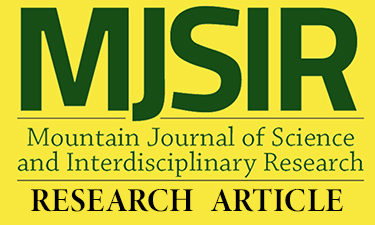Self-Care Practices of Miners in Sitio Midas, Itogon, Benguet
Main Article Content
Abstract
In the mountainous enclave of Sitio Midas, Itogon, Benguet, small-scale gold mining has sustained the community for decades, serving as the primary livelihood despite inherent health and safety risks. This qualitative research delves into the miners' perspectives on the potential hazards associated with their activities and the self-care practices they employ. Through semi-structured interviews and open-ended questions, the study actively engages miners and their families, drawing insights into their self-care strategies. Major findings underscore a heightened awareness of health risks, particularly chemical exposure, prompting the adoption of safety measures such as protective gear. Cultural influences deeply rooted in tradition significantly shape the miners' approach to self-care, with the study noting a gradual shift influenced by Christianity, supplanting long-standing customs. The miners express a dual reliance on government support, acknowledging the importance of seminars while advocating for alternative livelihood options. Despite the inherent limitations of the research, the results underscore the critical role of self-care practices in mitigating health risks within the unique context of small-scale gold mining in Sitio Midas. The conclusion highlights the resilience of miners facing environmental and health challenges and points to the need for comprehensive support systems beyond their existing efforts, indicating the broader implications for policy and intervention strategies in similar mining communities.
Article Details
References
Banes, G.G. (2019). Women’s Roles, Challenges, and Opportunities in Small-Scale Mining: The Case of Indigenous People in Loacan, Itogon, Benguet, Philippines. Mountain Journal of Science and Interdisciplinary Research, 79 (2 Suppl 1) : 4960. http://portal.bsu.edu.ph:8083/index.php/BRJ/article/view/236/319
Conant, J., & Fadem, P. (2008). A Community Guide to Environmental Health. Oakland, California: Hesperian Health Guides.
Cordillera Peoples Alliance. (2007). Case Study on the Impacts of Mining and Dams on the United Nations. United Nations: https://www.un.org/esa/socdev/unpfii/documents/workshop_IPPE_cpp.doc
Department of Environment and Natural Resources. (1997). Administrative Order No. 97-30 s. 1997: Small -Scale Mine Safety Rules and Regulations. Supreme Court E-Library. https://elibrary.judiciary.gov.ph/thebookshelf/showdocs/10/45608#:~:text=This%20Order%20shall%20govern%20all%20contractors%2C%20associations%2C,coal%20mines%20to%20effect%20a%20safe%20and
Granadillos, N.G., & Parafina, C.S. (2020). Assessment of occupational safety and health hazards. International Labour Organization, 8.
Fialen, J. (2005). Panagsayo: mining the indigenous way. Northern Dispatch. https://www.nordis.net/news/2005/ndw050410/ndw050410_13panag sayo.htm
Fry, H.T. (2006). A History of the Mountain Province. Quezon City: The New Day Publisher.
Haddaway, N.R., Cooke, S.J., Lesser, P., Macura, B., Nilsson, A.E., Taylor, J.J., & Raito, K.(2019). Evidence of the impacts of metal mining and the effectiveness of mining mitigation measures on social–ecological systems in Arctic and boreal regions: a systematic map protocol. Environmental Evidence, 8. https://doi.org/10.1186/s13750019-0152-8
International Labor Organization. (1999). Newsroom. International Labour Organization. https://www.ilo.org/global/about-the-ilo/newsroom/news/WCMS_007929/lang-en/index.htm
International Labor Organization. (2020). Assessment of occupational safety and health hazardsexposure of workers in small-scale gold mining in the Philippines. Environment Control Division Occupational Safety and Health Centre. https://www.ilo.org/media/397091/download
Jethro, M.A., & David, Ogbodo. (2018). Environmental and Socio-Economic Impact of Mining on Immediate Communities in Kogi State Central Nigeria. Journal of Environment and Earth Science, 8(11): 36-45. https://www.researchgate.net/publication/333681561_Environmental_and_Socio-Economic_Impact_of_Mining_on_Immediate_Communities_in_Kogi_State_ Central_Nigeria
Levin, M. (2018). Contested extractivism, society and the state: Struggles over mining and social metabolism in the Philippines. The Extractive Industries and Society, 5(3): 423-432. https://doi.org/10.1016/j.exis.2018.03.005
Leung, A.M.R., & Lu, J.L. (2022). Work Process and Hazard Analysis in Small-scale Gold Mining in Northern Philippines. Acta Medica Philippina, 56(1). https://doi.org/10.47895/amp.v56i1.3871
Mensah, A.K., Mahiri, I.O., Owusu, O., Mireku, O.D., Wireko, I., & Kissi, E.A. (2015). Environmental Impacts of Mining: A Study of Mining Communities in Ghana. Applied Ecology and Environmental Sciences, 3(3): 81-94.
National Academies of Sciences. (2001). Evolutionary and Revolutionary Technologies for Mining. Washington, DC: The National Academies Press. https://doi.org/10.17226/10318.
Scott, W.H. (1974). The Discovery of the Igorots. Quezon City: New Day Publisher.
Stewart, A.G. (2020). Mining is bad for health: a voyage of discovery. Environ Geochem Health, 42, 1153–1165. https://doi.org/10.1007/s1065301900367-7
Tujan, A., & Guzman R. (1998). Globalizing Philippine Mining. Manila: IBON Foundation, Databank and Research Center.
Witchalls, S. (2022). The Environmental Problems Caused by Mining. EARTH.ORG. https://earth.org/environmental-problems-caused-by-mining/

